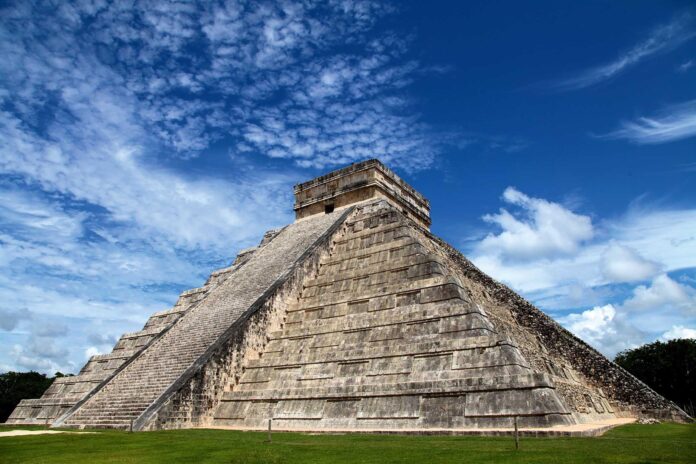A new museum at Chichén Itzá, the ancient Mayan complex located in the north of Mexico’s Yucatán Peninsula, will showcase some of the region’s latest archaeological discoveries, including some found during excavation work for the controversial Tren Maya (Maya Train) project.
The museum, which is still in the planning stages, will replace a much smaller building that closed more than ten years ago. It is likely to follow in the museo de sitio (site museum) model found at other complexes managed by the federal Instituto Nacional de Antropologia e História (INAH), with a permanent display of items found during excavations at or near the vast site, which is best known as the location of the pyramid of the serpent deity K’uk’ulkan, one of the seven wonders of the modern world.
It is believed that construction of the first buildings at the site, including temples with carved limestone stelae, was begun by the Itzá between AD500 and AD600. Chichén Itzá is now Mexico’s most visited archeological site, with around two million visitors a year. Some scholars have expressed concerns that excessive tourism is putting the complex and the pyramid, known locally as El Castillo (the castle) and dating from AD800, at risk. Until a few years ago, visitors could climb to the top of the pyramid, but authorities no longer allow them to do so.
In 2010, after decades of wrangling, the Mexican government bought the site from a local family, the Barbachanos, who had owned the land since taking it over from the heirs of Edward Thompson (1856-1935), an amateur archaeologist who was the American consul in the city of Mérida. Thompson spent 30 years exploring the site and recovered many artefacts that he sent to the Peabody Museum at Harvard University in Cambridge, Massachusetts, during the late 1800s. The Mexico government later accused him of trafficking antiquities and expropriated a large part of the land, returning it to his descendants decades later.
Diego Prieto, the director of the INAH, gave very little information about the specifics of the forthcoming museum at Chichén Itzá, who would run it and what its cost would be. The INAH has previously said that around MX265m ($14.4m) would be set aside for work at Chichén Itzá that would include building the museum, a new visitor centre and the conservation of around 23 ancient buildings at the complex.
Carlos Esperón, the director of the Maya Museum in Cancún, in the neighbouring state of Quintana Roo, tells The Art Newspaper that work on the museum “could take two years”. Even after preliminary surveying of the site is complete, he says, the project will proceed slowly, because “all the groundwork will be done manually in order to minimise the risk to any undetected structures”.
He adds that “it is possible that some of the objects on display in the Maya Museum in Cancún” might be loaned or moved to Chichén. “We have some superb reproductions of the Pagautunes, mythical characters who were very important in Maya cosmology—the Maya believed they held up the sky up—which you can see in some of the temples at Chichén. It is possible they may go to the new museum.”
Train brings trove of discoveries
As the massive Maya Train project has taken shape, teams of archaeologists have been working against the clock at sites all across the Yucatán Peninsula, which is made up of five states: Campeche, Chiapas, Tabasco, Quintana Roo and Yucatán. The train will pass through all five states, with stations near several pre-Columbian sites as well as several airports.
The huge infrastructure project has become a focus for protest from some Indigenous groups, who say they were not fully consulted about the train route. Environmentalists have also voiced concerns over the loss of biodiversity and the potential damage to the region’s limestone landscape, which is known for its large number of cenotes (underground lakes) and cave systems—many of which were sacred to the Maya.

Photo: Unsplash
The INAH has made many discoveries during excavations along the train route, according to a spokesperson for the institute. To date they include the remnants of 2,568 buildings, 202 items of personal property or vestiges of clothing, 244 ceramic fragments and 38 caves or cenotes.
In addition to building a museum, the INAH recently announced it would be opening a part of the Chichén Itzá site known as Chichén Viejo, which was previously off limits to the public. The area includes two platforms, one of which has been recently named after the British archaeologist Alfred Maudslay (1850-1931), who photographed and made a number of plaster casts of reliefs at the site in the 1890s. Many of his casts and copies are held at the British Museum in London.
Maudslay’s great-nephew, Richard Maudslay, is the current chair of the British Mexican Society. “My great-uncle carried out a very detailed analysis of the glyphs and his photographs are used to this day,” he says. “It is most appropriate that his contribution to Mayan studies should be publicly recognised and I look forward to seeing the Maudslay platform on my next visit to the site.”

























